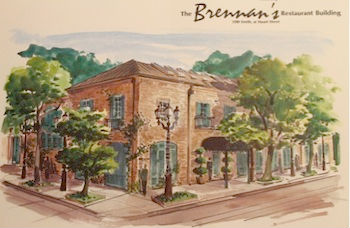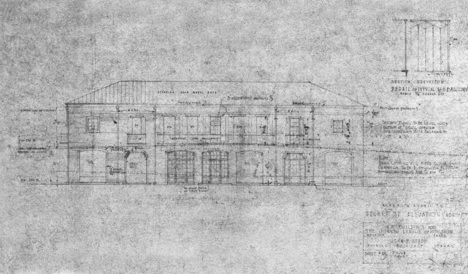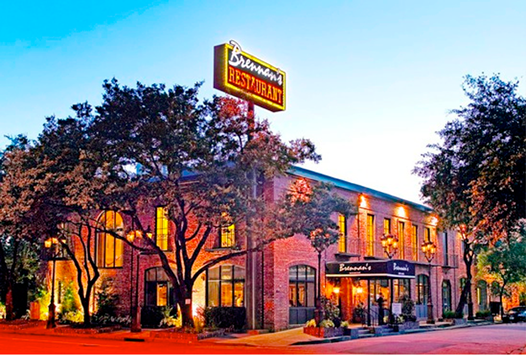
History of Brennan's Building
Introduction
The building that houses Brennan’s has a rich history rooted in both New Orleans Creole traditions and the local Houston community. Prominent Houston architect John Staub designed it based on an old house in the New Orleans French Quarter that dates back to 1795, which happened to be where Brennan’s of New Orleans moved to in 1956.
 When it was built in 1929, it housed the Junior League, a Houston women’s charitable organization. When the Brennans visited Houston to scout a location for their expansion, they immediately fell in love with the old Junior League building. In 1967, they opened Brennan’s Houston there, where it has remained ever since. The restaurant has survived floods, a tornado, and most famously the 2008 fire during Hurricane Ike, which nearly destroyed it, closing the restaurant for nearly a year and a half. Though severely damaged in the fire, the restaurant was faithfully restored, retaining 90% of the original exterior and giving the interior a highly-praised new look that retains the Creole atmosphere of the restaurant before the fire.
When it was built in 1929, it housed the Junior League, a Houston women’s charitable organization. When the Brennans visited Houston to scout a location for their expansion, they immediately fell in love with the old Junior League building. In 1967, they opened Brennan’s Houston there, where it has remained ever since. The restaurant has survived floods, a tornado, and most famously the 2008 fire during Hurricane Ike, which nearly destroyed it, closing the restaurant for nearly a year and a half. Though severely damaged in the fire, the restaurant was faithfully restored, retaining 90% of the original exterior and giving the interior a highly-praised new look that retains the Creole atmosphere of the restaurant before the fire.John Staub and the Junior League Building
John Staub was born in Knoxville, Tennessee in 1892 and received his Master’s degree in architecture from MIT in 1916. In 1921, he was sent to Houston on assignment for the prominent New York architect Harry T. Lindeberg. He decided to stay in Houston, setting up his own practice two years later. Staub became well-known for designing single-family houses, which have been described as “characterized by harmonious proportions, elegant detail, and fine materials”. Staub’s work is most associated with the neighborhood of River Oaks, where he designed thirty-one houses between 1924 and 1958. In 1928, he was commissioned by famous Houston philanthropist and patron of the arts Ima Hogg to design Bayou Bend, Mrs. Hogg’s house and now a museum which houses many of the artworks she had collected.

In 1929 Staub designed the Junior League Building, which now houses Brennan’s Houston. The Junior League is a Houston women’s charitable organization established in 1925 that is still active today. Staub designed the building in the Latin colonial style, basing it off of the 1795 Spanish Creole Rilleux House in the New Orleans French Quarter. The Rilleux House happens to be where Brennan’s of New Orleans relocated in 1956. The structure was built with exposed red brick and a copper roof, and the interior and courtyard hearkened back to traditional Louisiana houses. The original 1795 Rillieux House was most strongly evoked in the front of the building facing Stuart Avenue, with similar rhythmically-spaced windows and groupings of iron balconies. A 1929 issue of the old magazine Houston Gargoyle described the building as “a home of friendly charm, a place of Southern hospitality, a thought of old New Orleans in this bustling city of sudden, hazardous growth”. When Alex Brennan-Martin’s uncle was scouting a location for his family’s Houston expansion and saw the Junior League Building, a near-identical replica of the structure that housed Brennan’s in New Orleans, he knew immediately that it was the place they were looking for. When the rest of the Brennan family back in New Orleans saw it they agreed, and they opened Brennan’s of Houston there in 1967.
Brennan's of Houston Opens
The interior of the building was extensively remodeled when the restaurant opened. Chandeliers, skylights, a mahogany bar, richly-patterned fabrics adorning the walls, and an entrance hall with waxed-brick flooring and gas lamps provided a pleasant Creole-style dining atmosphere.
 Since 1967 the neighborhood surrounding Brennan’s Houston has been redeveloped into a sort of Houston French Quarter, with buildings following the style of the old Junior League building. The building survived a number of run-ins with forces of nature prior to Hurricane Ike, weathering several floods and a 1993 a tornado that tore off the roof, exposing the Garden room to the rain. None of these severely damaged the restaurant though- even after the tornado the building was fully-repaired in less than a month.
Since 1967 the neighborhood surrounding Brennan’s Houston has been redeveloped into a sort of Houston French Quarter, with buildings following the style of the old Junior League building. The building survived a number of run-ins with forces of nature prior to Hurricane Ike, weathering several floods and a 1993 a tornado that tore off the roof, exposing the Garden room to the rain. None of these severely damaged the restaurant though- even after the tornado the building was fully-repaired in less than a month.Fire
When Hurricane Ike rolled through Houston on September 13, 2008, the Brennan’s Houston building caught fire, destroying the roof and burning the second floor while causing smoke and water damage to the first floor. James Koonce, the Brennan’s “wine guy” and his four-year-old daughter were riding out the storm in the building along with General Manager Carl Walker when the fire happened.
 Koonce and his daughter and were severely burned, and Carl Walker was slightly injured. The fire was shocking news to those who had worked and dined there, as they watched the fire reported on the local and national news. Alex Brennan- Martin, contacted by phone the night of the fire, declined to comment as he was too emotional to speak. The Houston Chronicle food writer Allison Cook wrote that when someone told her about the fire, “It was as if he had told me a friend had died.” Cook had been a customer since the early ‘70s and had written on it a number of times. She had many fond memories of Brennan’s from the past few decades- she said it was “the place where I got comfortable with fine dining.”
Koonce and his daughter and were severely burned, and Carl Walker was slightly injured. The fire was shocking news to those who had worked and dined there, as they watched the fire reported on the local and national news. Alex Brennan- Martin, contacted by phone the night of the fire, declined to comment as he was too emotional to speak. The Houston Chronicle food writer Allison Cook wrote that when someone told her about the fire, “It was as if he had told me a friend had died.” Cook had been a customer since the early ‘70s and had written on it a number of times. She had many fond memories of Brennan’s from the past few decades- she said it was “the place where I got comfortable with fine dining.”Renovations and Reopening
On September 15, Alex Brennan-Martin told the Chronicle regarding Brennan’s, “We’re going to build it back”. He said he was also working with Amegy Bank to set up a fund to help pay for the Koonces’ medical costs. By the end of the month, friends of Koonce, community members, and other Houston restaurants joined Brennan-Martin and held a number of events to raise money for the Koonces’ medical costs. Brennan-Martin also helped the rest of Brennan’s employees find jobs elsewhere until the restaurant reopened.
In March 2009, Brennan-Martin, alongside Houston Mayor Bill White, officially announced plans to reopen Brennan’s Houston. The Houston-based Linbeck Construction – who built the Omni and St. Regis hotels in Houston – were to oversee the renovation alongside Pin Oak Interests and Studio Red Architects, who have participated in major projects such as Moody Gardens, Wortham Theater Center, and the Texas Heart Institute.

Brennan’s Houston reopened in February 2010. The press release announcing the reopening of the restaurant describes the renovations:
Though the interior of the building had to be gutted and refurbished, including a new roof, floors, and windows, the most iconic building elements were maintained… Ninety percent of the exterior façade was maintained, and some of the original design elements from the 1930 building were rediscovered.
Alex Brennan-Martin said his goal with the rebuild was to have people feel like they were coming back to an old family home that had been “gussied up”. He tried to undo some of the changes his family had made to Staub’s original design, for example uncovering some windows they had originally covered. He looked at some of the original dining rooms from when the restaurant opened in 1967 and tried to use similar colors but in a more contemporary fashion. Brennan-Martin wanted the new design to be in keeping with the history of the building while at the same time bringing it into the 21st Century.
Though Brennan-Martin was worried about how people would respond to the changes, the new design was very well-received. It was praised by food writers like Allison Cook as well as customers, who often described it as lighter and brighter. The renovation received awards from the Greater Houston Preservation Alliance and the Engineering News-Record.

